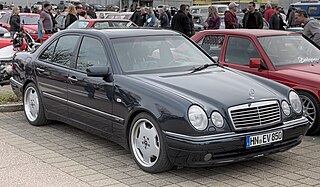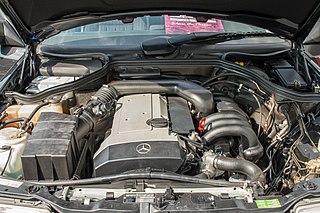Mercedes-AMG GmbH, commonly known as AMG, is the high-performance subsidiary of Mercedes-Benz AG. AMG independently hires engineers and contracts with manufacturers to customize Mercedes-Benz AMG vehicles. The company has its headquarters in Affalterbach, Baden-Württemberg, Germany.

Brabus GmbH is a German high-performance automotive aftermarket tuning company founded in 1977 in Bottrop. Brabus specialises mainly in Mercedes-Benz, Maybach and Smart vehicles. They have also modified other vehicles including Porsche.

The Mercedes-Benz M271 engine is a straight-4 automobile piston engine family used in the 2000s (decade).

The Mercedes-Benz M112 engine is a gasoline-fueled, 4-stroke, spark-ignition, internal-combustion automobile piston V6 engine family used in the 2000s. Introduced in 1996, it was the first gasoline V6 engine ever built by Mercedes. A short time later the related M113 V8 was introduced.

The Mercedes-Benz M113 engine is a gasoline-fueled, spark-ignition internal-combustion V8 automobile engine family used in the 2000s. It is based on the similar M112 V6 introduced in 1997, then later phased out in 2007 for the M156 AMG engine and the M273 engine.

The Mercedes-Benz W210 is the internal designation for a range of executive cars manufactured by Mercedes-Benz and marketed under the E-Class model name in both sedan/saloon (1995–2002) and station wagon/estate (1996–2003) configurations. W210 development started in 1988, three years after the W124's introduction.

The R170 Mercedes-Benz SLK-Class is the first generation of the Mercedes-Benz SLK-Class range of compact luxury roadsters manufactured by Mercedes-Benz between 1995 and 2004, using a shortened variant of the W202 Mercedes C-Class platform.

The OM617 engine family is a straight-5 diesel automobile engine from Mercedes-Benz used in the 1970s and 1980s. It is a direct development from the straight-4 OM616. It was sold in vehicles from 1974 to 1991. The OM617 is considered to be one of the most reliable engines ever produced with engines often reaching over 1,000,000 km (620,000 mi) without being rebuilt and is one of the key reasons for Mercedes' popularity in North America in the 1980s, as it was powerful and reliable compared to other automotive diesels of the time. It is also a very popular choice for the use of alternative fuels, mainly straight or waste vegetable oil and biodiesel, although the use of these fuels may cause engine damage over time if not processed properly before use.

The second generation Mercedes-Benz SLK, internally designated model R171, is a two-passenger, front-engine, rear-drive, retractable hardtop roadster, unveiled at the 74th Geneva International Motor Show—and manufactured and marketed for model years 2004–2010.

The Mercedes-Benz M104 is a automobile straight-six engine produced from 1988 through 1999. It has a double overhead cam design with 4 valves per cylinder, and used a crossflow cylinder head. It replaced the M103 and was replaced by the M112 V6 starting in 1997. The bore spacing on all M104 engines is the same as M103 engines.

The Mercedes-Benz M119 is a V8 automobile petrol engine produced from 1989 through 1999. It was available in 4.2 L; 5.0 L; and 6.0 L displacements. It was a double overhead cam design with 4 valves per cylinder and variable valve timing on the intake side. It was replaced by the 3-valve M113 starting in 1997.

The M156 is the first automobile V8 engine designed autonomously by Mercedes-Benz subsidiary Mercedes-AMG, as previous AMG engines have always been based on original Mercedes engines. The engine was designed to be a naturally aspirated racing unit, and is also used in a number of high-performance AMG-badged Mercedes-Benz models. The engine was designed by Bernd Ramler, famed by the design of the Porsche Carrera GT's 5.7-liter V-10 engine.

The C208/A208 Mercedes-Benz CLK-Class introduced in 1997 is a grand tourer produced by German automaker Mercedes-Benz. It was based on the W202 Mercedes-Benz C-Class launched three years earlier. The C208 coupé is the first generation of the Mercedes-Benz CLK-Class and was subsequently replaced by the C209 CLK-Class in 2002, although the convertible remained in production till March 2003 when replaced by the A209 CLK-Class. Production 233,367 units for the C208 when production ceased in May 2002 and 115,161 for the A208 which was assembled at the Karmann plant in Osnabrück.

The Mercedes-Benz M137 engine is a naturally aspirated, SOHC 60° V12 engine, with three valves per cylinder, 2 intake and 1 exhaust. It was built to replace the larger and heavier, yet more powerful, DOHC, four valves per cylinder, naturally aspirated, 6.0 L M120 V12 unit. The M137 was used briefly between 1998 and 2002 for the W220 S-Class and C215 CL-Class. The architecture is similar to M112 and M113 engines, and is designed to match the overall dimensions of a V8 unit with undersquare internal measurements. The crankcase was cast in a lightweight alloy with "Silitec" (silicon/aluminium) cylinder liners to save weight. The M137 is 80 kg lighter than its predecessor and features cylinder deactivation technology. Both displacement variants have 10:1 compression ratio.

The Mercedes-Benz M272 engine is an automobile piston V6 engine family used in the 2000s (decade). Introduced in 2004, it is based on the M112 V6 introduced in 1998.

The Mercedes-Benz M273 engine is a V8 automobile piston engine family used in the 2000s (decade). It was based on the similar M272 V6 introduced in 2004.
5G-Tronic is Mercedes-Benz's trademark name for its 5-speed automatic transmission, starting off with the W5A 580 and W5A 330 as core models.

Kompressor is a marketing name for forced induction (supercharged) Mercedes-Benz engines. The term is not widely used by other motor manufacturers.

Mercedes-Benz W202 is the internal designation for a compact sedan/saloon manufactured and marketed by Mercedes-Benz between 1992 and 2001, as the first generation of the C-Class, now in its fifth generation. Replacing the 190 series/W201 in June 1993, the C-Class sedan was Mercedes' entry-level model until 1997, when the company launched the A-Class. Production reached 1,847,382 over model years 1994–2000.

The Mercedes-Benz C-Class (W203) is the internal designation for a range of compact executive cars manufactured and marketed by DaimlerChrysler from 1999 to 2010, as the second generation of the C-Class — in sedan/saloon, three-door hatchback coupé and station wagon/estate body styles.



















